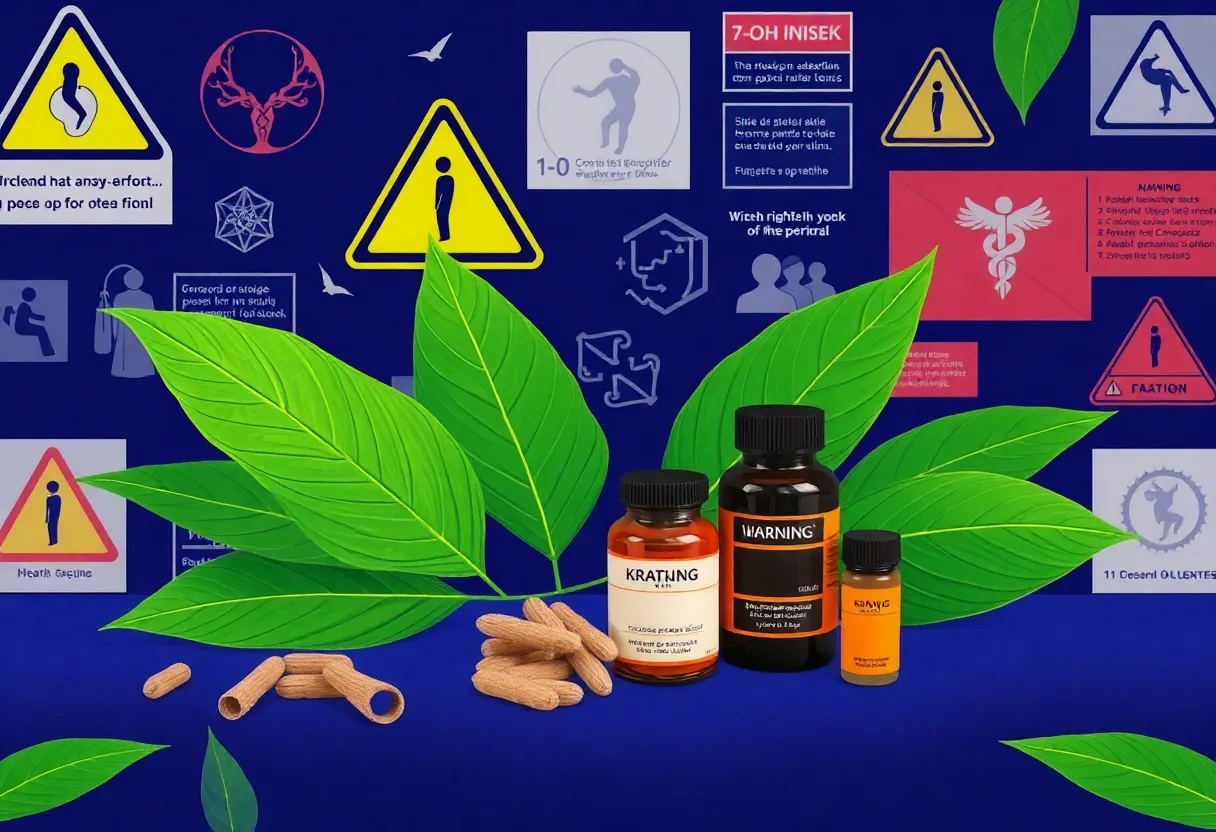News Summary
San Diego is under federal scrutiny as plans advance to classify 7-OH, derived from kratom, as an illicit substance. Health officials are alarmed by the rising addiction rates and deaths linked to these products, prompting local authorities to propose regulations. Experts are calling for immediate action against the lack of oversight on 7-OH products which are often marketed as safer alternatives. The FDA has warned about the dangers of 7-OH, while recent fatalities have raised public health concerns. Regulatory challenges complicate the situation as health officials monitor the spread of these substances.
San Diego is facing increasing scrutiny as the federal government moves forward with plans to classify 7-OH, a component derived from the kratom plant, as an illicit substance. This initiative aims to combat rising addiction levels and deaths linked to these products, which have become prevalent in local vape shops, liquor stores, and convenience stores.
Health and Human Services Secretary Robert F. Kennedy Jr. has backed recommendations to designate 7-OH as a Schedule I controlled substance. This classification would significantly restrict its use and distribution. The Drug Enforcement Administration (DEA) is currently reviewing the recommendation, although a final decision may take months or even years. Local substance use disorder experts are urging immediate action, highlighting the alarming lack of oversight on 7-OH products, which are often marketed as safer alternatives to traditional opioids.
The dangers of 7-OH have been echoed by the U.S. Food and Drug Administration (FDA), which has associated these products with addiction, seizures, insomnia, and respiratory depression. Local recovery organizations report seeing an uptick in individuals experiencing withdrawal symptoms after using kratom, particularly 7-OH products, as they often believe these substances to be safer. As tolerance builds rapidly with 7-OH, users may quickly find themselves addicted, facing serious withdrawal consequences.
The Origin and Composition of Kratom
Kratom, derived from a tropical tree indigenous to Southeast Asia, can have both stimulant and sedative effects, varying by dosage. 7-OH and mitragynine, two primary alkaloids in kratom, are responsible for its psychoactive effects. Recently, some companies have begun isolating and concentrating 7-OH for production into various consumables, including tinctures, tablets, gummies, and liquid shots. This trend has alarmed health officials, emphasizing the need for regulation.
Rising Numbers of Fatalities and Public Health Concerns
Health officials reported that there have been 17 deaths in 2023 connected to mitragynine, although only two cases considered it the sole cause of death. Additionally, Los Angeles County has linked three fatalities directly to 7-OH overdoses, noting that these cases involved individuals who also had alcohol in their systems. As the popularity of kratom as a remedy for chronic pain and anxiety continues to grow, so do reports of related addiction and overdose symptoms.
The California Orange County Board of Supervisors, along with San Diego and Oceanside, has responded to the rising dangers by initiating a ban on synthetic kratom products. Public health departments have issued warnings to consumers, advising them to avoid concentrated 7-OH products and to carry naloxone, a medication that can reverse the effects of opioid overdoses.
Historical Context and Regulatory Challenges
This is not the first time local authorities have attempted to regulate kratom in the area. In 2016, both San Diego and Oceanside enacted bans on kratom; however, enforcement was minimal, resulting in just three arrests and four citations. A California bill aimed at regulating kratom was shelved last year, largely due to opposition from industry stakeholders and a lack of consensus on necessary measures.
While advocacy groups for natural kratom products argue that concentrated 7-OH items could tarnish the industry’s reputation, the FDA maintains that no 7-OH products have received federal approval for safety or effectiveness. As the federal government and local authorities continue to grapple with the implications of these substances, health officials remain vigilant, monitoring the spread of 7-OH products and their potential risks to consumers, especially among minors.
Deeper Dive: News & Info About This Topic
HERE Resources
Additional Resources
- NBC San Diego
- Wikipedia: Kratom
- Los Angeles Times
- Google Search: Kratom 7-OH
- KENS 5
- Google Scholar: Kratom addiction
- Los Angeles Times
- Encyclopedia Britannica: Kratom
- KTLA
- Google News: synthetic kratom products
- San Diego Union Tribune

Author: STAFF HERE SAN DIEGO WRITER
The SAN DIEGO STAFF WRITER represents the experienced team at HERESanDiego.com, your go-to source for actionable local news and information in San Diego, San Diego County, and beyond. Specializing in "news you can use," we cover essential topics like product reviews for personal and business needs, local business directories, politics, real estate trends, neighborhood insights, and state news affecting the area—with deep expertise drawn from years of dedicated reporting and strong community input, including local press releases and business updates. We deliver top reporting on high-value events such as Comic-Con International, San Diego County Fair, and San Diego Pride Festival. Our coverage extends to key organizations like the San Diego Regional Chamber of Commerce and United Way of San Diego County, plus leading businesses in biotechnology, healthcare, and technology that power the local economy such as Qualcomm, Illumina, and Scripps Health. As part of the broader HERE network, including HEREAnaheim.com, HEREBeverlyHills.com, HERECostaMesa.com, HERECoronado.com, HEREHollywood.com, HEREHuntingtonBeach.com, HERELongBeach.com, HERELosAngeles.com, HEREMissionViejo.com, and HERESantaAna.com, we provide comprehensive, credible insights into California's dynamic landscape.





